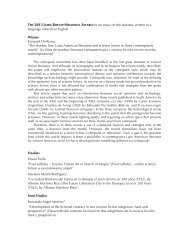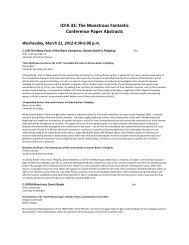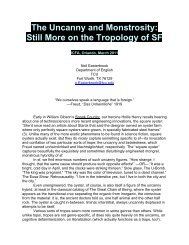Never Sleep Again: Resurrecting the <strong>Fantastic</strong> Beast in A Nightmare on Elm StreetJoseph L. LewisDelta College“Never Sleep Again” employs Joseph D. Andriano’s explication on the tropological revision of the monster to analyze the representationalboundaries of Freddy Krueger in New Line Cinema’s A Nightmare on Elm Street franchise. Andriano makes a distinction between metaphor andmetonymy to analyze the monster. As a metaphor, the monster is a representation of a human characteristic in which the human obtainsbestial characteristics; inasmuch, this bestial human experiences a transformation from the human to the monster and in some cases, from themonster to a human. As a metonym, the monster is represented in juxtaposition to the human. In this case, the monster ironically becomes acultural signifier for the culture in which he terrorizes partially due to the fact his transformation is a result of a secret from an unspeakablepast. As a metaphor, Krueger is demarcated as the Other prior to and post his violent and horrific transformation from human to beast. In thiscase, his transformation into the beast is both actual and symbolic. As a metonym, he is represented in juxtaposition to the human. Here,Krueger’s image signifies the dark id of the human collective consciousness.Embracing the Tribes of the Moon and the Order of the Gash: <strong>The</strong> Possibility of (Meta)cultural Identities in Clive Barker's Hellraiser andNightbreedTony M. VinciSouthern Illinois University, Carbondale<strong>The</strong> cultural trajectory of the horror film in the 1980s shares an unfortunate history with the European fairy tale. Through its intensely graphicand visceral depictions of murder, dismemberment, and supernatural violence, 1980s horror cinema embodies a host of working-class anxietiesregarding the effects of living in a post-industrial, postmodern milieu engulfed in the nebulous and dehumanizing workings of late capitalism.Yet, because of these graphic aesthetics, middle and upper class critics and scholars coded them as immature, violent, and artistically crude. AsZipes says of the Fairy Tale, “the bourgeois establishment had to make it seem that the fairy tales were immoral, trivial, useless and harmful ifan affirmative culture of commodity values supportive of elite interests were to take root in the public sphere” (17). Thus, the horror film’scultural capital was reduced and their artistic import nullified by their position as mindless, violent entertainment of the ignorant masses.However, through persistently radical depictions of post-human bodies, revolutionary action, “deviant” sexual expressions, alternativepsychological and metaphysical possibilities, much horror film of the 1980s works to create sites of critical engagement wherein both culturalcritique and a constitution of what I term (meta)cultural identity is explored and asserted. By (meta)cultural identity, I refer to a mode ofsubjective identity formulated in hopes of recognizing the legitimacy of acculturated identity while simultaneously transcending acculturation.It is not either/or; it is both/and: cultural identity and metacultural identity, which creates a third, liminal space for one to live within andwithout culture. (Hence my use of brackets around “meta” in [meta]cultural.) This (meta)cultural reconfiguration is perhaps expressed mostforcefully in the cinematic production of Clive Barker: Hellraiser (1987) and Nightbreed (1990).59. (VPA) <strong>Monstrous</strong> Nature MagnoliaChair: Jen SchillerMontclair State UniversityMagnificent Monster GardensCris HassoldNew College of FloridaThis paper considers three gardens – the Sacred Grove or Monster Garden at Bomarzo created by the Count Pier Francesco Orsini in 1552, inmemory of his wife Guilia Farnese, the Tarot Garden created by Niki de Saint-Phalle, again in Italy but produced in the twentieth century, andone by Leslie Fry and her father, John, for the Boca Ciega Park in Seminole, Florida – to consider the monstrosity of their hybrid forms.<strong>The</strong> Profane Amongst the Holy: <strong>The</strong> Strange Imagery of the Green Man, the Wodewose and the Sheela-na-Gig in Medieval Churches of theBritish IslesRobert FaleerCentral Michigan UniversityThis proposed paper will explore the purpose and meaning of the wodewose and the sheela-na-gig to show how they ultimately served thereligious agenda of the medieval Church. <strong>The</strong> paper will focus on carvings found inside and occasionally outside medieval parish, collegiate,monastic and cathedral churches throughout the British Isles.What Is That Thing?: <strong>The</strong> Grotesque Beasts of H.G. Wells and Patricia PiccininiNancy HightowerUniversity of Colorado, BoulderThis paper considers the ways that Australian artist Patricia Piccinini continues and deepens the discourse Wells started by creating uncannymonsters which elicit the full range of emotional juxtapositions the grotesque promises: fear, pity, wonder, laughter, terror, and even love.
60. (H/IF) Ancient and Medieval Monsters DogwoodChair: Franc AuldUniversity of Baraboo/Sauk CountyAbsenting Narratives in the Werewolf Tale of MelionRyan BrownUniversity of Alabama at HuntsvilleIn the thirteenth-century Old French Breton Lai, Melion, the title character one day shows his wife that he can transform into a werewolf withthe help of stones housed in a ring he wears. When he then transforms into a wolf to prey upon a stag whose meat his wife desires, she quicklytakes the ring and departs for her homeland in Ireland, leaving Melion permanently canine. <strong>The</strong> narrator claims at this point, “Now she hadwhat she required” (200). What does this line mean for our interpreting the poem and the werewolf’s role, not merely in this text but innumerous medieval werewolf tales? Giorgio Agamben identifies the transformation into a werewolf as the subject’s crossing into a zone ofindistinction, wherein he may be killed with impunity but not sacrificed like the homo sacer. But the narrator’s telling us that Melion’s wife “hadwhat she required” calls into question the power, or, rather, powerlessness, that Melion’s plight as the hunted wolf assumes. Is it he that weshould feel sorry for? I will suggest that this paradoxical line points to an absent narrative in Melion, one in which we might have learned thewife’s motivations for beguiling her lycanthropic husband. Such a reading implicates the narrator as well in what might be heard as amisogynistic voice, absenting a narrative that might have justified the wife’s actions. My reading will recast Melion’s shape-shifting as themachinations of sovereign power, and his later alignment with Arthur himself, on an imperial mission to Ireland, only further implicates thewerewolf not as the figure of homo sacer but as the sovereign himself. <strong>The</strong> other female voices, those that collectively claim to hate the wolfknight,further point to this absent narrative putting pressure on Melion’s strange vow to love only a wife who has never thought of anotherman besides him, a pure and, thus, sacred wife. This kind of reading complicates gendered voices in the Breton Lais, which often assume amisogynistic tone and yet whose most famous proprietor, Marie de France, was decidedly female.Snakes on a Plain: Monsters and Art Horror in Lucan’s Civil WarJames LohmarUniversity of FloridaThis paper argues that Lucan’s Civil War can be regarded as a work of proto-horror featuring monstrous and grotesque elements. In the poem’sninth book, the author unleashes a cadre of supernatural snakes upon the wearied Cato and his Republican troops. I examine Lucan’s virtuosotechnique in this scene and highlight Roman anxieties concerning violence in art and mimetic carnage. Critics of art horror often cite Aristotle’sprescription that tragedy inspires ‘pity and fear’ in one’s audience, and Lucan understands this precept (cf. Carroll 1990, Freeland 2000 andWorland 2007). Yet, Lucan further understands Aristotelian aesthetics, which prefer literary works constructed like well-proportioned animalbodies (soma). For Lucan, Aristotle’s soma-text equates to the Latin corpus (‘body of work’). When the Prester serpent causes Nasidius’ corpusto expand into a body ‘exceeding human size’ (BC 9.789-804), he offends and explodes Aristotelian anatomy in order to horrify his reader.Likewise, the Haemorrhois induces Tullus to bleed from his eyes, ears and pores (BC 9.805-14). Poor Sabellus’ body turns inside-out and meltsinto a pool of viscera and venom (BC 9.762-88). Worland, qua film critic, redeems such art horror succinctly: “outrageous violence is on display,no mistake; but so is formal control.” Lucan’s formal control – his deployment of poetic devices and rhetorical flourish – betrays his ballisticapproach to literary composition and aesthetics. Readers variously describe his outré interests: ‘nervous laughter’ (Bartsch 1997), ‘dark humor’(Martindale 1993), and ‘comic ugly’ (Johnson 1987). Through humorous asides and macabre scenery, Lucan points up the horror and absurdityof civil war. His violence expresses an assault on the aesthetics of his age, a detonation of the inherited literary tradition. This paper builds on abody of scholarship that privileges aesthetic judgments in literary criticism. <strong>The</strong> ancient and modern corpus metaphors elide into a linguisticdeterminative for aesthetic response. If other epics construct the body of literature, Lucan’s places that corpus under siege, makes it the targetof aestheticized violence. Like his prophetic zombie corpse in <strong>The</strong>ssaly, Lucan’s battered poetic corpus proclaims the hellish work of civil war.In Myself, a Monster: A Critical Reading of <strong>Monstrous</strong> Bodies and the Implications of Monsters and Contrapasso in Dante’s InfernoMegan MandellFlorida Atlantic UniversityRecent scholarship debates the use of Dante’s classical monsters and their allegorical and symbolic presence, many times referencing parallelsof meaning derived from their placements in the original text. Geryon, Cerberus, even Satan himself has come to be seen as a representativeconstruct of Dante’s Classical discourse. This paper intends to progress beyond the allusion, indeed beyond the theology of the Monsters wholead us through Inferno, and focus rather on the bodies of the shades in their monstrous contortions. <strong>The</strong> paper examines Dante’s use ofClassical monsters as mirrored reflections of the human condition, debased and dehumanized, each a contrapasso engendered to reflect thelack of humanity present when God’s Grace is absent. As the Classical monsters suggest the separation of soul and intellect from their propernature in the way their own bodies are deconstructed, so Dante suggests that the shades, whose bodies are in various states of deformity, aresuffering a secondary contrapasso to the active punishment – that their own “monstrous” bodies are appropriated according to their sins.Dante’s idea is that the body is the projection of the true self; this is why shades have no technical substance, but can still feel torturous pain.Once the shades have been relegated to their significant space in Inferno, the making of their bodies into something “other” than Human allowsfor their separation from the human population and their transcendence into monstrous territory. <strong>The</strong> bodies, then, are reflective of thedefects in their souls. <strong>The</strong> punishment is that they identify with the monsters rather than with the qualities of being human, as evidenced bytheir responses to the Pilgrim’s body and the treatment of their own.
- Page 4 and 5: 5. (F) Wondrous Bodies of the Gende
- Page 6 and 7: Fantastic Suicide: Reading the Unca
- Page 8: Viral Posthumanism: Boundaries and
- Page 11 and 12: The Concept of Soul Divisibility in
- Page 13 and 14: Thursday, March 22, 2012 10:30 a.m.
- Page 15 and 16: 21. (CYA) Terrifying Futures: Post-
- Page 17 and 18: 23. (FTV/H) Now I’m Feelin’ Zom
- Page 19 and 20: Fight Club: Amalgam of the Horrific
- Page 21 and 22: Taking the Monsters out of the Clos
- Page 23 and 24: Kaspar J. SaxenaIndependent Scholar
- Page 25 and 26: 44. (CYA) The Monstrosity of Teenag
- Page 27 and 28: 46. (FTV/SF) Monstrous Spin-offs: T
- Page 29 and 30: 49. (F) Aspects of Miéville Captiv
- Page 31 and 32: 53. (SF) War and Crisis in 1940s an
- Page 33 and 34: Abuse of Power: An Evolutionary Res
- Page 35: Disappearing Natives: The Colonized
- Page 39 and 40: 62. (F) The Works of Tolkien Captiv
- Page 41 and 42: 67. (SF) Imperial and Postcolonial
- Page 43 and 44: Beheading the Gorgon: Beautifying C
- Page 45 and 46: 71. (VPA) Monstrous Music MagnoliaC
- Page 47 and 48: 73. (F/IF) Portraying New Worlds Ca
- Page 49 and 50: Friday, March 23, 2012 2:45-3:45 pm
- Page 51 and 52: 81. (FTV) Those Damn Dirty Apes! Cy
- Page 53 and 54: Friday, March 23, 2012 4:00-5:30 pm
- Page 55 and 56: 92. (F) Leaving the Demonized Other
- Page 57 and 58: 94. (FTV/CYA) Monstrosity and Devia
- Page 59 and 60: of cannibalism, ghostly seduction i
- Page 61 and 62: Saturday March 24, 2012 8:30-10:00
- Page 63 and 64: 104. (CYA) Classic Monsters, Reinte
- Page 65 and 66: 107. (VPA) Monstrous Gaming Bodies
- Page 67 and 68: who challenge the order that the Br
- Page 69 and 70: Reading Between the Times: A Critic
- Page 71 and 72: 117. (FTV) Monsters and Superheroes
- Page 73 and 74: 119. (IF/H/PCS) International Mash-
- Page 75 and 76: Focusing on Stoker's Dracula as one
- Page 77 and 78: Florida Atlantic UniversitySheri S.
- Page 79 and 80: Simmons CollegeIn the spate of rece
- Page 81 and 82: Independent ScholarKing’s story
- Page 83 and 84: modernity opens up for every indivi
- Page 85 and 86: Saturday March 24, 2012 4:00-5:30 p
- Page 87 and 88:
141. (FTV) Monstrous Masculinity Cy
- Page 89 and 90:
ultimately make peace with her mons
- Page 91 and 92:
where the almost-human sentient zom





